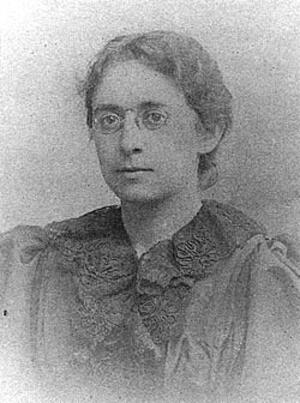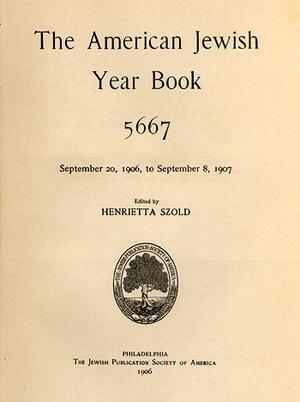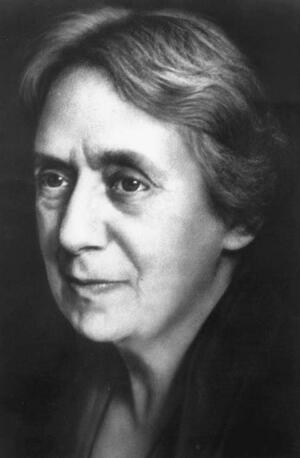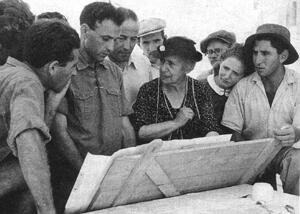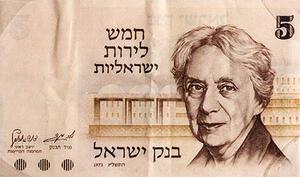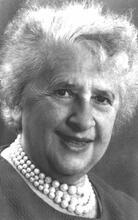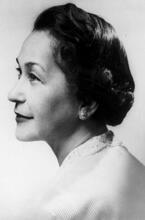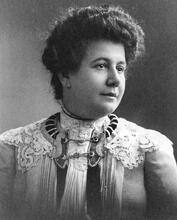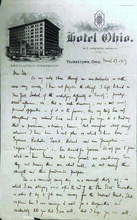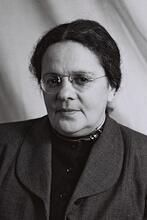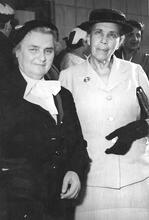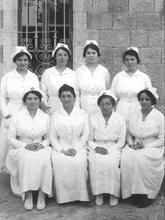Henrietta Szold
Henrietta Szold was an educator, essayist, editor, social and communal worker, and Zionist organizer. After studying at the Jewish Theological Seminary, she served as executive secretary of the Jewish Publication Society’s publications committee, editing and publishing many important works of Jewish history. But her greatest accomplishment was the creation of Hadassah, the women’s Zionist organization of the United States. Under her direction, Hadassah became the largest and most powerful Zionist group in the United States, fundraising and setting up hospitals, food banks, nursing schools, and social work programs. Szold’s work helped create the medical, educational, and social service infrastructure that helped turn the dream of a Jewish state into a workable reality. During the 1930s, she spearheaded Youth Aliyah, helping Jewish children leave Nazi Germany for Palestine.
Overview and Early Life
Henrietta Szold was a woman of many contradictions. She was a family person who lived largely in the public arena. Possessed of only a high school diploma, she edited and published some of the monuments of modern Jewish scholarship and later helped to shape the educational system in Palestine. American to the core, she devoted herself to Zionism and lived the last quarter century of her life in Palestine. Her work in rescuing children from the Holocaust and rehabilitating them earned her the sobriquet “mother of the Yishuv” (the Jewish community in Palestine before 1948).
Educator, essayist, editor, social and communal worker, Zionist organizer, and politician, first in the United States and then in Palestine, Szold was born in Baltimore, Maryland, in 1860 at the outbreak of the American Civil War and died in Jerusalem during the closing months of World War II. Her life was touched by some of the most momentous events of modern American, Jewish, and world history. Her prodigious capacity for work and unwavering sense of duty, her powerful intellect and ability to meet new challenges, the breadth of her activities, and her singular contributions to American Jewish culture, to Zionism, and to the Jewish community in Palestine prior to the establishment of the State of Israel. "Old Yishuv" refers to the Jewish community prior to 1882; "New Yishuv" to that following 1882.Yishuv mark her as an extraordinary human being.

Courtesy of Jewish Museum of Maryland
Szold was the oldest child of liberal-minded Rabbi Benjamin Szold and his wife Sophie, who had come to the United States from Central Europe a year before Henrietta’s birth. Although a Lincoln supporter in a city with southern sympathies, Benjamin Szold was a traditionalist in Jewish matters and a scholar well versed in both sacred and secular studies. His firstborn was her father’s spiritual and intellectual heir. Her record at Western Female High School was never equaled, but it was at home that she learned German and Hebrew, as well as Jewish sacred texts. In her teens, she served her father as amanuensis, translator, and editor.
Career in Teaching and Publication
A born teacher, Szold was hired straight out of high school to teach French, German, and algebra at the Misses Adams’s English and French School for Girls and Judaism at the school of her father’s congregation, Oheb Shalom. When, in the 1880s, waves of Jewish immigration from Eastern Europe brought to Baltimore a large number of Russian and Polish Jews, she assisted the immigrants in establishing a night school in which to learn English and civics. To her, Americanization was not “the opposite … to Jewish living and thinking” but rather the process of empowering the disfranchised. By 1894, over nine hundred immigrants, both Jews and gentiles, were registered in her night school. Some years later while a student at the Jewish Theological Seminary in New York—upon enrolling, she was required to sign an undertaking that she did not aspire to the rabbinate, which was then a male preserve—Szold assumed a more unusual pedagogical assignment: teaching English to her instructors, most of whom were recent immigrants from Europe. From 1918 to 1920, she played a national role in education, heading the Education Department of the Zionist Organization of America.
About the same time she began to teach, Szold embarked upon a career as an essayist and editor. As “Shulamith” and under her own name she wrote in an increasingly fluid style for the New York Jewish Messenger and other journals on a variety of issues of concern to the American Jewish community. In 1888, she was invited to be one of nine members—and the only female—of the publications committee of the new Jewish Publication Society (JPS), which would rapidly establish itself as one of the premier cultural institutions of American Jewry. Two years later, she collaborated with the young Cyrus Adler, a Semitics scholar who was to become head of the Jewish Theological Seminary, the American Jewish Committee, and Dropsie College, in writing a section on the United States for JPS’s first publication, Lady Katie Magnus’s Outlines of Jewish History. It was “the first ever textbook summary of its kind covering American Jewish history,” and it set out clearly the young authors’ sunny view of their native country. “No spot in the land can be connected with bitter or painful reminiscences,” they wrote, “a proud boast, which America alone … may utter.” Szold also assisted JPS in the editing of the classic History of the Jews by Heinrich Graetz, the German Jewish historian.
In 1893, she became the first full-time (executive) secretary of the publications committee, serving until 1916. Her pioneering, hardworking, and meticulous stewardship inaugurated a new era in the history of JPS. Szold, however, received less than her share of recognition, partly because of her diffidence and politeness, but perhaps, too, because of her gender. Among the works she translated were Simon Dubnow’s Jewish History: An Essay in the Philosophy of History (1903) and Nahum Slouschz’s The Renascence of Hebrew Literature (1905). From 1898 to 1909, she was instrumental in producing the American Jewish Year Book, which quickly became the indispensable record of American Jewish organizations and affairs. She translated, edited, and indexed much of the monumental Legends of the Jews compiled by Jewish Theological Seminary scholar Louis Ginzberg, as well as his other works. At her urging, the publications committee began seriously to consider Yiddish literature. During her tenure, the Schiff Library of Jewish Classics was launched, and the JPS Bible translation project, which resulted in the publication of the Jewish Revised Standard Version, was begun and completed.
Zionist Leadership and Creation of Hadassah
Szold was drawn to Jewish nationalism in its earliest days, becoming a charter member of the Baltimore Hevras Zion in 1893 together with her friend Dr. Harry Friedenwald, an early president of the Federation of American Zionists (FAZ). In fact, Zionism became her third American “career.” In a speech delivered a month before the publication of Theodor Herzl’s Der Judenstaat in 1896, Szold outlined her philosophy of Zionism, which included not only the ingathering of the exiled Jews in their ancient land but also the revival of Jewish culture. Two years later, she became a member of the FAZ executive committee, the only woman in the group; later she agreed to serve as secretary—a post often reserved for women in male-dominated organizations—and set about trying to bring order to the chaotic affairs of the federation. During World War I, she served as secretary of the Provisional Executive Committee for General Zionist Affairs headed by Louis D. Brandeis, which assumed the leadership of the world movement rent asunder by the war. There, too, she was the only woman in the group.
In 1909, in the company of her mother, she traveled to Palestine for the first time and visited the Zionist agricultural settlements as well as the holy sites. During that trip, when she was already forty-nine years old, Szold found her life’s vocation: the health, education, and welfare of the Yishuv. The next year, she became secretary of the board of the new Agricultural Experiment Station established in Palestine by Aaron Aaronsohn. It was her first official connection with the reconstruction work in the Jewish homeland.
Of her American activities, that which had the greatest and most lasting influence was the creation of Hadassah, the women’s Zionist organization. In 1896, Szold had argued that “sexless [gender-free] work is the great desideratum.” Later, however, she eagerly accepted certain tasks as especially appropriate for women and all-women’s groups as appropriate settings for the accomplishment of those tasks.
In 1907, at the invitation of Rabbi Judah Magnes, who was to become a close friend and coworker, Szold joined a small women’s gathering called the Hadassah Study Circle, one of several such groups in New York, where she was then living. In 1912, she and some friends formed the Daughters of Zion-Hadassah Chapter, which had enlisted 122 members by the fall of that year. Some of the FAZ members expected the new society to serve as a ladies’ auxiliary of their own group. Szold envisioned an independent social service organization modeled along the lines of the women’s agencies, which had recently proliferated in the United States. She sought to bring into being a group guided by the principles of American progressivism: project orientation; “trained and willing forces; [and a] ... tested organization.” It was to be altogether different from the predominantly male Zionist societies, such as the FAZ. They were infused with the very different spirit of Eastern Europe; they were romantic and amateurish, not scientific and businesslike. Under her direction, Hadassah became the largest and most powerful Zionist group in the United States. And, despite its founder’s avowedly nonpartisan Zionism, the organization became a major political force in the American and world movements.
Work and Leadership in Palestine

Courtesy of the Jewish Museum of Maryland.
The first major project undertaken by Hadassah was the establishment of an American-style visiting nurse system in Jerusalem in 1913. Its success earned Szold the praise of Jane Addams, the pioneer American social worker. Five years later, Hadassah organized and helped to fund the American Zionist Medical Unit, which brought American medical personnel and a field hospital to Palestine. The unit began the reformation of medical care in the Holy Land with the establishment of a nursing school, dental, medical, and X-ray clinics, hospitals, a hygiene department, infant welfare stations, and the medical sanitary expedition. From the 1920s, Hadassah supported medical services and education in the Yishuv. Its medical institutions exemplified American efficiency and showcased American technology, bringing to Palestine, and then Israel, a standard of medicine equal to that of the wealthy Western nations. In the 1930s, at Szold’s behest, Hadassah assumed the support of Youth Lit. "ascent." A "calling up" to the Torah during its reading in the synagogue.Aliyah programs for refugee and problem children in Palestine.
In 1920, Szold herself arrived in Palestine to take charge of the Medical Unit, soon to be renamed the Hadassah Medical Organization (HMO). As a woman and an American, she was doubly an outsider in the Yishuv, which was dominated by Eastern Europeans. She remained for three stormy but productive and innovative years, although her insistence on American standards and work habits was stoutly resisted, and labor circles resented what they perceived to be medical imperialism. Gradually, however, coworkers and the public were won over. After a lengthy home leave, Szold returned to Palestine in 1925 as resident mentor to the new HMO director, and in subsequent years played a supporting, but still significant, role in the affairs of the organization.
In 1927, Szold was appointed by the World Zionist Congress to its three-member Palestine executive, with responsibility for the health and education portfolios. The executive was charged with bringing the budget of the Yishuv into balance, a thankless task that created constant friction with the indigenous Yishuv leadership. Szold became a special target of attack because it was felt that her American friends were failing to meet their financial commitments to Zionism. She agreed but believed that the existence of the Yishuv would be endangered if its financial affairs were not put in order. The schools, which had no money for supplies or teachers’ salaries, she saw as a case in point.
To survey the educational system, Szold brought to Palestine Isaac B. Berkson, an American Jewish educator who was a disciple of W.H. Kilpatrick and John Dewey. Berkson remained on as director of the executive’s Department of Education, first working with Szold to balance the education budget and to ensure that teachers would be paid on time, then embarking on bringing a measure of American educational reform to Yishuv schools. By the time Szold was removed from the executive when it was reorganized in 1930, she had succeeded, Berkson remarked, in setting the schools “on the way to orderly and effective administration and financing.” The educational publisher and Tel Aviv municipal councilwoman Shoshana Persitz claimed that Szold had singlehandedly succeeded in gaining legitimacy for education in a community that then viewed manual labor as the only noble occupation. In fewer than three years she had made a major impact on the Yishuv educational system and, despite the economic restraints she helped to impose and the earlier disapproval with which she and the HMO were regarded, had gained the respect of a wide public. The laborites came to appreciate her progressive American sympathy for the underdog, endorsement of the trade union ideal, and suspicion of wealth as the marks of an ally.
Social work was the third area of Yishuv life to which Szold made a significant and lasting contribution. While still in America, she had perceived the need to improve the lot of Palestine’s women. She proposed that American “settlement workers” teach the women pioneers “modern housework and other domestic industries,” and at the same time “rouse a noble discontent among them” to spark demands for “better sanitation and better living conditions.” Once on the scene, she realized that the men of the Yishuv also lived a harsh life, and she began to investigate ways to ease the burdens of all.
During her first year in the country, she helped to organize the Federation of Hebrew Women to engage in social work activities. While sitting on the Zionist executive, she tried to bring to the Yishuv the American concepts of scientific social work and casework through her involvement with local charitable agencies such as the Nathan Straus Soup Kitchen. Her most important contributions in this area, however, were made between 1931 and 1939 when she held the social welfare portfolio of the Lit. "assembly." The 120-member parliament of the State of Israel.Knesset Yisrael, the semiautonomous legislative body of the Yishuv, which had called her back to Palestine from America in 1931.
Already in 1930, she had produced the report “The Future of Women’s Work for Palestine,” which outlined a plan for systematizing social work throughout the Yishuv. She sought to replace, as she put it, “the old Lady Bountiful system, based on hysteria and not on justice to the unfortunate.” With aid from wealthy American friends, she succeeded by 1934 in establishing modern social service agencies in Jerusalem, Tel Aviv, Haifa, and Petah Tikva, as well as the Social Service Department of the Knesset Yisrael. The next year she opened the country’s first school of social work, which later became the School of Social Work of the Hebrew University.
Youth Aliyah and Later Work
Szold’s perceptiveness regarding Hitler’s threat—she traveled to Nazi Germany for Youth Aliyah and met with Jews and gentiles including dissidents such as the artist Käthe Kollwitz—led her to believe that the Yishuv would face an unprecedented wave of immigration in the 1930s. Remembering her experiences with the Eastern Europeans in Baltimore, Szold endeavored to convince the Yishuv leadership that immigrants required special “emotional and intellectual support.” Although she encountered opposition to immigrant-aid work in general, there was more receptivity to the notion of assisting children.
It was not she who first conceived of Youth Aliyah as a means of rescuing young people from Nazi Europe. But she was the person who understood the administrative complications and how to cut through them, and the social and emotional problems the children would have and how to solve them. Because of her “cabinet” position in the Yishuv administration, she was able to ensure that the children would be properly looked after, and she had the connections with Hadassah, which provided most of the funds. Moreover, Szold genuinely cared for children. Her work with Youth Aliyah made hers a household name in her native country. Public recognition came in the form of regular birthday tributes from the famous and from ordinary people, especially children (she painstakingly answered every letter), and in the award of an honorary degree by Boston University in 1944, her only university degree.
When warclouds gathered in 1939, many of the Americans in Palestine returned home. Szold might well have followed. She was very attached to her sisters Rachel Jastrow, Adele Seltzer, and Bertha Levin and to their families. (Rachel had died in 1926, and Sadie, to whom she was not close, had died earlier.) A life member of the International Longfellow Society from 1916, she remained American in her sensibilities and culture to a considerable extent. (At her last A seven-day festival to commemorate the Exodus from Egypt (eight days outside Israel) beginning on the 15th day of the Hebrew month of Nissan. Also called the "Festival of Mazzot"; the "Festival of Spring"; Pesah.Passover Lit. "order." The regimen of rituals, songs and textual readings performed in a specific order on the first two nights (in Israel, on the first night) of Passover.seder in 1944, she sang African-American spirituals.) She had come to Palestine at the age of sixty, after all. Moreover, she was a pacifist and troubled by the increasing militancy of the Yishuv in its dealings with Britain and the Arabs. She participated in both the Brith Shalom and the Ihud, associations of intellectuals mostly of American, British, or Central European background such as Rabbi Magnes and Martin Buber, which promoted the notion of Palestine as a binational, Arab-Jewish state. But Szold did not return to the United States. She thought “it right and proper” to “stay with the community” where she had lived for two decades.
Szold’s early objective for the Yishuv had been to reform it along the lines of the Progressives’ vision for America. As time went on, however, she moved away from her former associates and friends in America, although not from her family. Her values became less American. She never rejected her homeland and always thought of it in positive, although not uncritical, terms. From an apostle of Americanism in Palestine, she developed into an interpreter of the Yishuv to America. She strongly believed that one day “Palestine, resplendent intellectually,” would repay “to the Lit. (Greek) "dispersion." The Jewish community, and its areas of residence, outside Erez Israel.Diaspora its whole investment … in terms of spiritual succor, stimulation and strength.” In 1936, she told her former colleagues in the Zionist Organization of America that, “philosophically considered, there is nothing but Zionism … to save us.” She died in Jerusalem, at the modern medical center that Hadassah had erected, on February 13, 1945.
Brown, Michael. The Israeli-American Connection: Its Roots in the Yishuv, 1914–1945 (1996).
Current Biography (1940): 785–786.
Dash, Joan. Summoned to Jerusalem: The Life of Henrietta Szold (1979).
DAB 3 (1973): 756–758.
Dictionary of Jewish Biography (1991): 512–514.
EJ.
Kutscher, Carol Bosworth. “The Early Years of Hadassah.” Ph.D. diss., Brandeis University, 1976, and “From Merger to Autonomy: Hadassah and the ZOA, 1918–1921.” Herzl Yearbook 8 (1978): 61–78.
Lowenthal, Marvin. Henrietta Szold, Life and Letters (1942).
NAW.
New Encyclopedia of Israel and Zionism (1994).
Sarna, Jonathan D. JPS: The Americanization of Jewish Culture, 1888–1988 (1989).
Szold, Henrietta. Papers. Central Zionist Archives, Jerusalem.

